Ultimate Home & Garden Guide, Roger Keyserling [top 10 most read books in the world txt] 📗

- Author: Roger Keyserling
Book online «Ultimate Home & Garden Guide, Roger Keyserling [top 10 most read books in the world txt] 📗». Author Roger Keyserling
• The hill system can produce both high yields and large fruit, provided you diligently remove all runners that are produced before they root. The plants will branch and become very productive.
Planting Strawberry plants should be grown on raised beds to avoid wet feet and root rot conditions; it also makes them much easier to pick. Beds should be raised as high as possible, 12-18", and formed to 2'wide on top, with 40'' between beds, center-to-center. After beds are raked smooth and pre-irrigated, open a V-shaped hole about 6-7' deep with a trowel. Place a level teaspoon of slow-release fertilizer or ammonium sulfate in the bottom of each hole and cover with approximately 1' of soil to prevent root burn. Spread the roots out in a fan shape in a fan shape in the hole and cover with soil, firming it around the roots. Set plants at the exact level that they were growing in the nursery, not too high nor too deep. Plants set too high will be weak, and plants set too deep will rot. Evenly space plants from 8-15' apart in the bed, depending upon the ultimate size of that particular variety
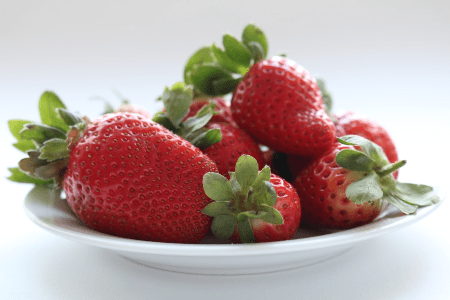
Strawberries grow well in a variety of sandy or loam soils. These soils provide good drainage and warm up more readily during the day, which is especially important during cooler parts of the growing season.
When strawberry fields are being prepared for planting, the soil is fumigated using an approved broad spectrum pesticide to kill soil organisms that can harm the growing plants or lead to decay of the fruit.
Raised beds are then created and covered with plastic liners which limit plant and berry contact with soil. Protecting the plants and berries from contact with the soil and standing water helps to prevent decay, pest damage, and contamination. The liners also trap heat from the sun, allowing for extension of the growing season, and they limit weed growth. There are various colors of opaque liners that are used in different regions and provide different degrees of heat absorption.
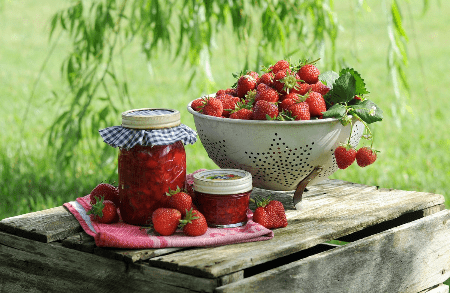
Watering is one of the most essential parts of getting initial plant growth started no matter what you might be planting, and the watering phase is also what inspires new plant growth from there. Berries are one of the juiciest fruits out there, and this should already be an indication for newer gardeners that they are going to require a bit more water than some of their counterparts – but this doesn’t mean you should overwater them, either.
Strawberry plants have shallow roots and require consistent moisture throughout the growing season. Newly planted plants are generally overhead irrigated at one week intervals (1" of water) to get good initial vegetative growth and then switched over to drip irrigation as the season progresses. Overhead irrigation can be used during the growing season but should be monitored carefully to minimize the time period that the plants and fruit are actually wet. Drip irrigation keeps the moisture away from the fruit and prevents fruit rot. It is generally run every day during the summer for 1-2 hours.
Water sources used to irrigate strawberry fields are many from underground wells to surface water. The source type depends on the growing region and resources available to the farmer. Irrigation water is most often delivered to the strawberry plants via drip irrigation systems. These systems use rubber or plastic tubing buried in the raised beds to deliver water to the roots where it is needed. Drip irrigation also protects the fruit from contact with irrigation water, which could transmit plant and human pathogens or cause mildew and premature softening.
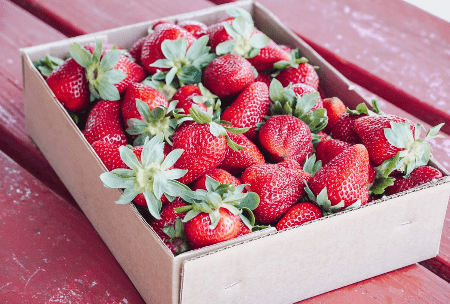
Pest, wildlife, and rodent control on strawberry farms is part of a good strawberry safety program. Controlling these pests helps protect the quality and safety of the berries. This is common on many produce farms, not just strawberry farms.
During the growing season in some regions, temperatures can drop below freezing. When this happens, it is sometimes necessary to apply water to the growing strawberry plants to protect them from frost.
Most home garden strawberry plantings are mulched. Any organic material free of weed seed makes good mulch. Hay, straw and pine needles are most frequently used. Mulch should be applied 2 to 4 inches deep over and around the plants after the first freezing weather in the fall. This protects them from heaving and freezing injury during the winter. After the danger of frost is over in the spring, about half the mulch should be raked off the plants into the area between the rows. Mulch left around the plants will help keep the berries clean, conserve moisture and check weed growth.
Checklist for taking care of your mature plants
• Protect the planting from frost if possible. Avoid planting in frost pockets, or use row covers.
• Control weeds.
• Irrigate as required.
• In the hill system, remove all runners that form.
• In the matted-row system, train runners to the row (12–18 inches wide); remove all runners that form after September
June-bearers
• Pick fruit from June to July.
• Renovate the planting after harvest, or remove it if it’s no longer productive.
• Fertilize in late summer.
• Irrigate if necessary.
Everbearers and day-neutrals
• Pick fruit in June and July and in the fall (for day-neutrals, pick throughout the season).
• Remove the planting if it’s no longer productive.
• Fertilize; make three or four applications from spring through early August.
• Irrigate if necessary.
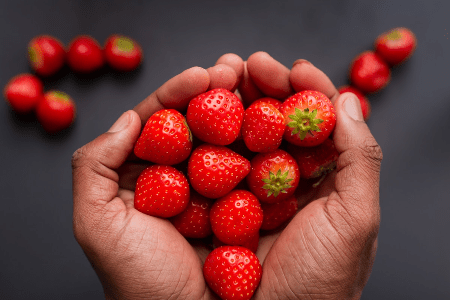
Insects
Weevils- several attack strawberries, both above and below ground. Most insecticides are ineffective, and so abandoning the planting and moving to a pest-free area is recommended. Spider mites- these tiny insects produce webbing and stippling of the foliage, stunting the strawberry plants and reducing yields and fruit quality. Dusty conditions contribute to spider mite populations. Overhead watering , especially when combined with an insecticidal soap, is effective in controlling most mites by washing them off the plants and destroying their habitat.
Aphids- can damage foliage, stunt plants, and cause damage to the fruit during the early, cool part of the season. Generally, insecticidal soap applied at weekly intervals provides adequate control.
Leaf rolling caterpillars- the salt marsh caterpillar and cutworm will feed on strawberry plants. These can be effectively controlled with Bascillus thuringiensis (BT), Dipel, Thuriside, etc.
Slugs and snails- feed on foliage and fruit. They can be controlled with applications of Metaldehyde with repeated applications.
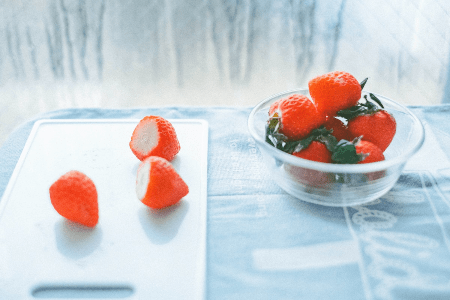
Fertilizing
Before planting, incorporate 2 pounds of 5-10-5 or 5-10-10 fertilizer or 3/4 pound 21-0-0 ammonium sulfate per 100 square feet into the soil. Beginning before bloom in April, side dress with one-eight pound of ammonium sulfate (21-0-0) per 100 square feet per month until mid-August.
At Keywebco we use our own compost and very lightly use any chemicals.
Commercial growers almost exclusively use chemical fertilizers. Use of compost is rare. Fertilizers can be added by injection into the soil, through the irrigation system by injecting into the water (also known as chemigation), or added as a side dressing in the furrow which is then distributed when it rains.
there’s a lot to be gained from the plant’s harvest. Including a long list of health benefits owing to the fact that they’re much higher in vitamins and minerals compared to fruits that are twice their size.
What could be better than picking strawberries out of your very own garden? Any gardener knows that few things are as satisfying as literally picking the fruit.
Harvesting In the garden, strawberries should be allowed to attain an overall red color and become fully ripe before harvesting. It is at this stage that the sugar content is highest and the flavor is best. It is necessary to harvest every day or every other day during the peak of the season.
Harvest the berries carefully by the stems to prevent bruising. Pick all that are ripe, since they will not keep until the next harvest. Ripe strawberries may be held for a day or two in a refrigerator.
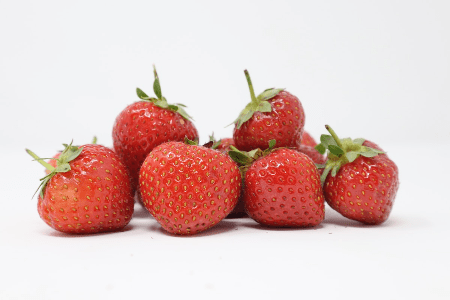
Here are tips for your strawberries
1 – If your strawberries grow in sunny places, you'll get the best flavor.
2 – Strawberries like air, so to say. Give them at least one foot of soil depth and 8 inches between each row of plants.
3- Strawberries don't like waterlogging. Under these conditions, they'll rot easily, so your soil drains well.
4 – One of the best places to grow strawberries is in elevated beds, as you have more influence over the weather.
5 – Try to grow your strawberries where long sunny days and cool nights benefit.
6 – One of the worst enemy strawberries is snow. The best crops will be found from plants planted in early September, but if frost is going to be an issue, then wait until mid-April for summer strawberries. Perpetual strawberries will already be planted mid-April.
7 – Avoid windy spots as it is difficult for insects to pollinate small flowers.
8 – Avoid growing strawberries on land previously used to grow grass as wireworm will make short work of any strawberries before you get a chance. You should also avoid growing strawberries in soil that were previously used to grow eggplants, tomatoes, potatoes, or peppers as this could cause a verticillium wilt problem.
9 – We like strawberries because of their bright color, and they look strange because their seeds are outside the fruit. However, this also means they are attractive to birds, so avoid them attacking your fruits when they start to form by placing wire netting over them when the fruits start to form.
10 – A great final tip is to cover the plant base with stone-secured straw or plastic bin liners when the fruit begins to grow. When they get larger, fruits appear to get weighted down and come to rest on the soil where they start rotting. By the way, if you're using plastic bin liners or similar to prevent this scenario, make sure you 're holes in it to allow drainage or your fruit will rot.
One of the key factors to remember when successfully growing strawberries is the soil. Soil make-up, composition, compositing, and fertility must be considered. The best type of soil for strawberry growing is a soil that allows not only maximum sunshine and sun rays to touch it, but also very good drainage. The best soil for strawberries is hard clay soil and sometimes sandy soil. A sloppy piece of land, as well as a rolling piece of land, will provide better circulation of air and water drainage, which will be great for strawberry plants.
These are the key things to consider when planning to grow strawberries in your home garden. Proper care and maintenance result in healthy plants producing beautiful sun-kissed berries. Use plenty of mulch and periodically change the strawberry site position to avoid the recurrence of diseases and soil-borne problems. Make sure there are no weeds and various other unwanted plants or pests and bugs in the area. There are many simple ways to build good eating habits, and there's a huge difference in how you look.
Picking Fresh Fruits And Vegetable Guidet’s





Comments (0)